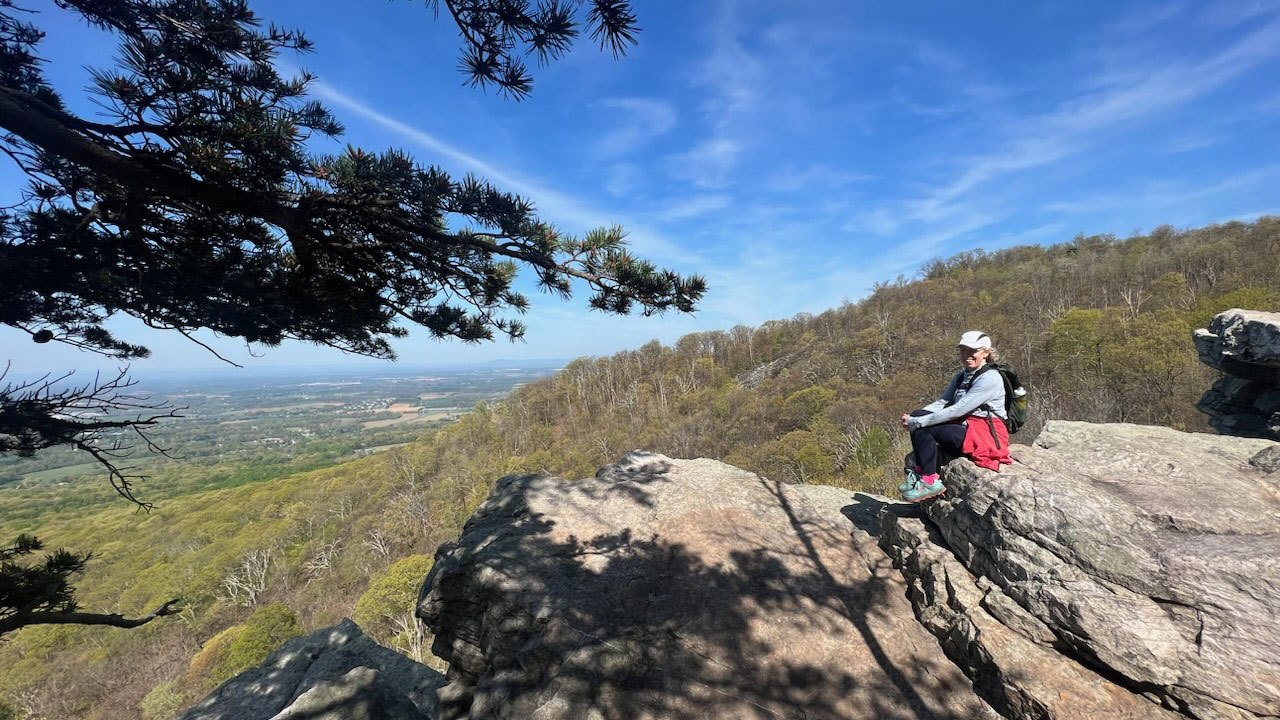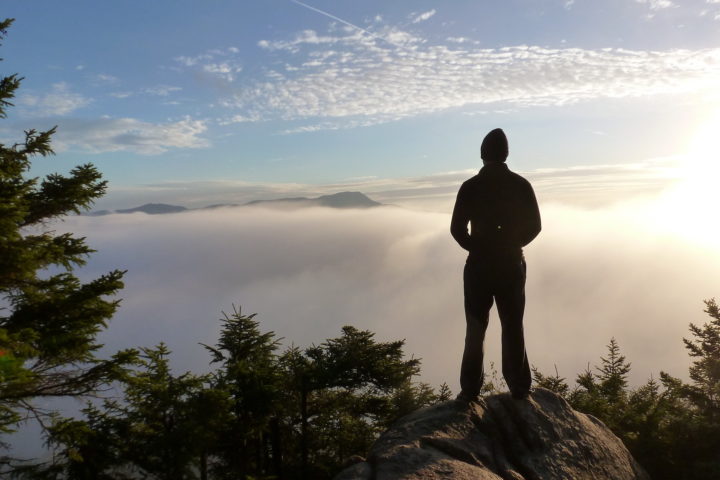Science-Backed Benefits to Time on the Trail
3 Ways the Appalachian Trail Improves Mental Health
June 2, 2023
Blue light glows from our phone and computer screens while devices all around us buzz, chime, and ring. As our lives become more entwined with technology, spending time in nature is essential for our well-being. The Appalachian Trail (A.T.) makes a great place to reap some of the mental health benefits of spending time outdoors.
This blog post covers some of the science behind three of the best mood-boosters that the Trail provides visitors: natural light, birdsong, and walking or hiking.
Natural Light
Whether you’re admiring the dappled light that filters through the green tunnel or soaking in the A.T.’s sunny summits, spending time in the sun (with proper sun protection) on the Trail has benefits to overall well-being. Research published in Environmental Health Perspectives reveals that exposure to natural light can positively influence our mental health, sleep patterns, and even physical health. Natural light stimulates the production of serotonin, a neurotransmitter associated with mood regulation, leading to improved mood and reduced symptoms of depression.

Photo by Rachel Smith
Furthermore, a Journal of Clinical Sleep Medicine study suggests that exposure to natural light during the day helps regulate our body’s internal clock, promoting a healthy sleep-wake cycle. Spending time soaking up a little sun on the Trail can actually assist in combating sleep disorders, such as insomnia.
Birdsong
Birdsong contributes to our well-being in surprising ways and is one of the best parts of the A.T. soundscape. A study in BioScience found that exposure to bird sounds in green environments positively impacts mental health. The sounds of nature, particularly birdsongs, have been linked to reduced stress levels and increased feelings of relaxation.
 Plus, because many people live in urban environments with noise pollution, birdsong can provide an escape from the noise and may increase concentration and creativity. Click below to more about the birds you might see or hear along the A.T.
Plus, because many people live in urban environments with noise pollution, birdsong can provide an escape from the noise and may increase concentration and creativity. Click below to more about the birds you might see or hear along the A.T.
Meet the A.T.’s Frequent Fliers
Walking & Hiking
Walking or hiking in natural areas like the A.T. not only promotes physical fitness but also fosters mental well-being. A study published in Preventive Medicine found that spending time outdoors for moderate-intensity physical activities, such as walking or hiking, can reduce the risk of chronic illnesses like heart disease and diabetes.
Additionally, research from the Journal of Environmental Psychology reveals that walking in green spaces leads to improved mood, increased self-esteem, and reduced anxiety and depression symptoms. The Trail’s beauty and tranquility can help us disconnect from daily stressors, fostering mental clarity and enhancing our overall sense of happiness and well-being.

Photo by Ilana Copel
Stepping outside onto the A.T. grants us the remarkable benefits of natural light, birdsong, and a place to be active in nature. The robust body of scientific evidence (see below for a few select resources) that supports the influence of nature on our mental health demonstrates what many Trail lovers already know to be true — the A.T. plays a significant role in our overall health and well-being.
Ready to take advantage of the mental (and physical) health benefits of spending time on the A.T.? Click the link below to plan your next visit.
Sources
Barton, J., & Pretty, J. (2010). What is the best dose of nature and green exercise for improving mental health? A multi-study analysis. Journal of Environmental Psychology, 30(4), 501–509. http://coping.us/images/What_is_the_Best_Dose_of_Nature_and_Green_Exercise_for_Improving_Mental_Health_-Barton_Pretty_2010_.pdf
Burkhart, K., Phelps, J. R., & Amber, D. (2009). Amber lenses to block blue light and improve sleep: A randomized trial. Journal of Clinical Sleep Medicine, 5(6), 563–566. https://jakabstore.com/wp-content/uploads/2021/12/AMBER_LENSES_TO_BLOCK_BLUE_LIGHT_AND_IMPROVE_SLEEP_A_RANDOMIZED_TRIAL.pdf
Fuller, R. A., Irvine, K. N., Devine-Wright, P., Warren, P. H., & Gaston, K. J. (2007). Psychological benefits of greenspace increase with biodiversity. BioScience, 57(7), 621–630. Ncbi.nlm.nih.gov/pmc/articles/PMC2390667/
Kesaniemi, Y. K., Danforth, E., Jensen, M. D., Kopelman, P. G., Lefèbvre, P., & Reeder, B. A. (2001). Dose-response issues concerning physical activity and health: An evidence-based symposium. Preventive Medicine, 33(5), 452–459. https://www.sciencedirect.com/science/article/abs/pii/S0091743501909120?via%3Dihub
Lewy, A. J., Lefler, B. J., Emens, J. S., & Bauer, V. K. (2016). The circadian basis of winter depression. Environmental Health Perspectives, 124(10), 410–416. https://www.pnas.org/doi/full/10.1073/pnas.0602425103
Discover More

Official Blog
Protecting the A.T. Hiking Experience
Ever since the first foot of the Appalachian Trail was cleared, visitor use management has been essential for protecting A.T. resources and guiding hikers toward safe and Trail-friendly practices.

Plan and Prepare
Hiker Resource Library
A collection of resources for hikers to stay safe, healthy, and responsible on the Appalachian Trail.

BY CAITLIN MILLER
11 Easy Ways to Improve Your Leave No Trace Footprint
A collection of simple and seemingly small ways you can practice Leave No Trace and help protect the A.T. experience.
